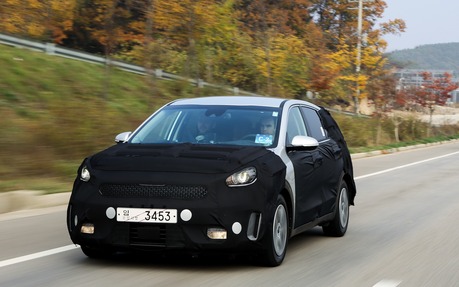Kia Niro Hybrid: Putting The Prius On Notice
Taking risks is an important step in the growth of any automaker. The next roll of the dice for style-conscious Korean automaker Kia? The Niro, a compact utility vehicle that gambles on Canadian customers transferring their loyalties to the brand's very first dedicated hybrid. In a move designed specifically to challenge the supremacy of Toyota's Prius family – or at least make Prius v shoppers waver for a second or two before doing what they're told by Japan's hybrid hegemony – the Kia Niro straddles the line between hatch and crossover on its way to posting impressive fuel efficiency.
I was given the rare opportunity to pilot a very early version of the Niro on the rough and tumble roads that crisscross the industrial region just outside of Seoul where Kia has planted its research and design headquarters. Despite not being allowed to take any pictures of the hybrid crossover without its heavy camouflage make-up, my time behind the wheel of company's electric-powered mover gave me enough of an impression to form a definite image of its potential for success.
Under The Mask
The versions of the Kia Niro that were allowed to leave the R&D compound were effectively masked from prying public eyes, but earlier in the day I was able to get a clear look at an early prototype of the hybrid, both inside and out. Truthfully, the Niro's Prius bogey is readily apparent in the crossover's sheet metal: this is one Kia that doesn't rock the boat when it comes to styling. While all of the standard Kia design elements are present and accounted for (and ground clearance has been sufficiently adjusted to validate its SUV cred), the Niro's clean lines lean a blander taste on the palette than other, more visually expressive models in the automaker's line-up. The decision to tone down the Niro's looks might play well with more conservative hybrid shoppers, but it's also likely to turn off existing Kia customers looking to take advantage of the crossover's thrifty practicality.
On the inside, things are more status quo. The Kia Niro hybrid adopts a dashboard treatment that will be familiar to anyone who's ridden in one of the company's smaller vehicles, with the exception of the additional eco-related information presented by the gauge cluster. The rear seat is reasonably roomy for a compact car, but folding down that split back bench reveals a two-tier load floor (albeit one that could very well be finessed into flatness by the time production rolls around) and a cargo area that sees some intrusion from the downward curve of the Niro's roofline.
On The Road
Kia has consciously broken with conventional hybrid wisdom by rejecting continuously-variable transmissions in favour of traditional automatics in its other battery-assisted designs. The Kia Niro takes this a step further by subbing in a dual-clutch automated manual to handle the gear-shifting duties, a move that can be explained by the presence of a 1.6-litre four-cylinder engine drawn from the same Kappa family found in other Kia models (where turbocharged editions also sport a DCT).
The gearbox plays nice with the just over 100 direct-injected horsepower provided by the gas engine and 32 kilowatts on tap from the electric motor. Kia hasn't committed to a combined output figure for the new setup, but judging from the specs we were shown and my own, uncalibrated butt dyno, I'd venture it's somewhere in the range of 130 to 145 ponies. As a result, acceleration is predictably modest, and while it is possible to manually step through the Niro's six forward ratios using the console-mounted shifter, there's little performance prize for doing so.
No, the Kia Niro's rewards are instead doled out at the fuel pump, which owners will certainly see less and less often thanks to the predicted 4.7 l/100 km the hybrid has been designed to return in combined driving. In fact, while official testing has yet to be certified, Kia is actually aiming for an even lower number, once again sighting the Prius' gaudy stats.
Moving past its mechanical details, the Niro provided me with very predictable handling over roads so rough that the engineer riding behind me could barely contain his disdain for the route selection that had been handed down from on high, and road and engine noise wasn't nearly as intrusive as I had prepared myself for, given the vehicle's prototype status. Of particular note is the hybrid's regenerative braking system, which has been meticulously tuned to avoid the non-linear pedal feel that has been characteristic of the brand's other hybrid designs.
A Worthwhile Effort
If I was Honda – and to a lesser extent, Toyota – I'd have a healthy paranoia concerning the phenomenal strides that Kia (and corporate parent Hyundai) have made over the past decade. The decision to go ahead with a dedicated hybrid model riding on its own unique platform demonstrates that Kia's aspirations to further displace the market share of its Japanese rivals are both deep and relentless.
Scheduled for release late next year, the appeal of the Niro will be closely linked to the price on its window sticker and the willingness of Canadians to rally around a tall-riding crossover hybrid that leaves all-wheel drive off of the options list (albeit mechanically feasible to implement, I was told by engineers). Above all, however, it stands as a battle flag planted deep into undiscovered territory that was once the exclusive province of but a few other automakers. Here there may have once been dragons, but now there's also the Niro. That alone should be enough to keep to keep more than a few rival product planners awake at night.
